#reserach portfolio
Explore tagged Tumblr posts
Text
portfolio reserach

www.theaoi.com


people have so many different styles of portfolio, and being able to submit your portfolio is a good resource i didn't know about, and i may do it at some point when i can refine my portfolio a bit more.
0 notes
Text
CINE1102: Research Portfolio

Introduction
This portfolio analyses all of the research I have made, which are accompanied by annotations on why I made those design choices and what was working well and what wasn’t, as well as any changes that I have made to my project based on what feedback and what I thought wasn’t working well. Along with the research, this portfolio also contains large amounts of experimentations in Unreal Engine, which I will be showing multiple examples through images or videos.
In this assignment, we were asked to form groups and come up with an idea and create and animation based on that idea. The idea we have agreed on revolves around pollution in the ocean caused by plastic; we wanted to create something that had meaning is a serious topic because our goal in this project is to not only create a beautiful animation, but also to raise awareness on what plastic is doing to our oceans.
We are also required to create a research portfolio on an idea for an animated product that focuses on any recognised specialist area of the animation process. The role I have chosen to focus on is being the Unreal Engine developer because I had a lot of fun in working on Unreal Engine last year in Games Design Principles and would love to continue working on it this year for this project.
Since our idea is based around oceans, I would need to do a lot of research to be able to create a realistic and accurate water simulations because although I am already comfortable using UE4, I have never created an underwater scene before so I immediately looked at tutorials about creating underwater scenes in Unreal as well as looking at oceans in general for reference so that I could carefully study the ocean, its movements and everything it entails. I bookmarked any related video that I could potentially use in the future and watch them when working on the next element.
Roles:
Maninderpal Rajbansh – Pre-Production Artist/Animation Director
Benedict Kpaku – Character Artist/Designer
Eduardo Gal – Secondary Character Artist/Story Designer
Maris Zaharevics – Environment Artist/Designer
Raimon Wenz – Unreal Engine Developer
Darren Pagado – FX Artist/Lighting
Samuel Fagboyegun – Sound Designer
Callum Watt – Sound Designer/Supporting Environment Artist
Mood Board
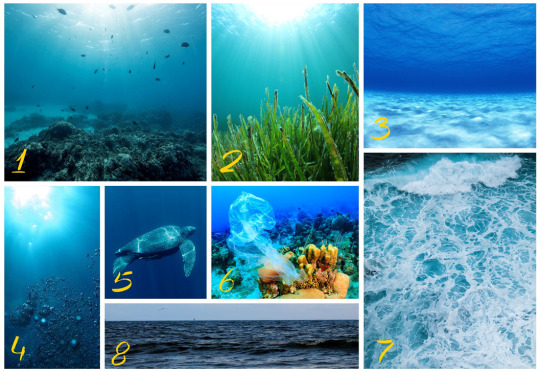
I searched online for various images and possible reference points for my initial draft of the underwater scenery and put them together to create a mood board. I chose different types of images related to the ocean and most of these helped me during the early stages of the project.
1: Polluted Ocean
I added this image of a dying/dead coral reef here because that’s what the environment of our animation is going to be due to the pollution caused by plastic. I was mainly interested in the colour scheme of this image; it had that ‘gloomy’ feel to it so I wanted to capture that in my scene by having that same colour palette of bluish-grey hues to amplify the effect that pollution has on the ocean which would not be achieved by having a colourful coral reef or a colourful environment in general.
2 & 4: God Rays
Although the god rays are more on Darren’s side of work, I still added these to my mood board. Since I am the person who is in charge of putting everything together in Unreal, I will also need to look around the different areas of Unreal that Darren is doing (which are mainly particle effects and lighting) because it is important for me to know how they will look so that I will be able to determine whether they fit into my scene and if they don’t then I can adjust the values to make them more suitable and more compatible with the rest of the UE4 project. #4 also includes bubbles, which Darren is also creating so I wanted to see how bubbles look underwater when being shined on by light from the sun.
3 & 5: Caustics
I am also creating the caustics which is why I needed to look at reference images and place them into my mood board to see how they look when being reflected onto the ocean floor, mainly sand. I also included an image of caustics being applied to a moving subject, which in this case is a sea turtle, which is perfect since the main character in our animation is also a sea turtle.
6: Plastic Bag in a Coral Reef
At first glance, it appears that the blob-shaped object on the left is just a jellyfish but after closer inspection, it is a plastic bag that is floating in the ocean and it merely resembles a jellyfish. I thought that this was interesting due to the glance value it has; while brainstorming, an idea was brought up where we could have a scene where we have a silhouette of a coral reef or a marine creature in the distance but once approached, would turn out to be plastics that are clustered together to form the shape of a marine creature or a coral reef and this image is a perfect example for that idea.
7 & 8: Ocean Waves
Waves are an important factor of any ocean scene so I made sure that I would be doing research on waves and looking for references for different types of waves and deciding which kind of wave would work for our scene; perhaps maybe use stronger waves during the climax of the story? And also perhaps use calm waves on scenes where our main character is simply just exploring the ocean. I will need to take these different scenarios in mind when choosing what height/colour/intensity of waves to use in different scenes of our animation.
Post-Processing
The post process volume arguably has the biggest impact on making a realistic underwater scene because it’s what gives the screen a blue hue to simulate water as well as having other nice effects such as depth of field, specular bloom, ambient occlusion, lens flares and more, which is why I will most likely be focusing on this factor the most in this project so that I could get the perfect balance and correct values in order to create a convincing underwater scene.
To start things off, I sculpted a placeholder landscape and moulded it to make it look like the land around a lake - although our idea was set in the ocean, this was just a first draft so I wanted to create something small just to see how things would look together and how doable this idea actually is in Unreal. I also added a Rock Basalt material that is found in the Starter Content provided by Epic to the landscape so that it wasn’t just a monotonous colour.
The next step in creating my underwater scene was to add the “water”; In order to create a convincing illusion of being underwater, I added a post-process volume into the scene and played around with the colour values for a couple of minutes to get that right shade of blue I wanted.
https://www.youtube.com/watch?v=n5UKw_Crlr4
(Matt Taylor, 2016)
https://www.youtube.com/watch?v=Gr5BDGahdEA
(Gamedev1909, 2015)
I mainly watched these two tutorials to help me create my water volume and I combined some parts from one video to the other to achieve the effect I wanted and also to see which values they used for the different variables and played around with those values to see if they would have an improvement. Matt Taylor also had other videos on his channel which have other factors that would further make the scene look more realistic which I also used for some of the sections that I will be talking about below.
Depth of Field
“Depth of field is the effect in which objects within some range of distances in a scene appear in focus, and objects nearer or farther than this range appear out of focus.”
(Joe Demers, 2007)
I added depth of field because during the animation, there will be some parts where the viewer’s attention should be targeted towards the sea turtle, so adding depth of field would be a good way to blur out the coral reef in the background and focus more on the turtle to give the scene a better sense of depth, but want to achieve a good balance in the blur strength as I prefer effects to be subtle since I will be combining multiple effects at once and I don’t want to overload the viewers with on-screen effects.
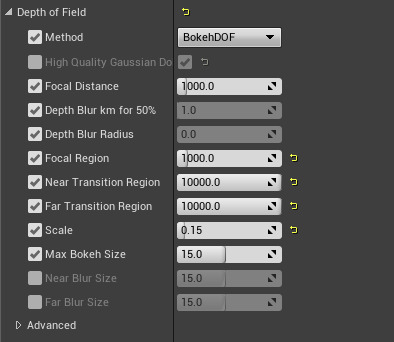
One of the main things that I noticed from those two tutorials above was that their depth of field values were too high and was causing everything to look very blurry, which is not the result I wanted so I reset the depth of field values and set my own values in the parameters and also tried out the other depth of field methods since they were using the GaussianDOF (which was too strong for my liking) and I wanted to see if the difference between each method. I liked the BokehDOF the most since the blur wasn’t too strong and it was only a subtle effect, which I really liked. These values will change over the coming months as I continue to play around with the values since I tend to always change the values of parameters every now and then to try and get a better effect, so the values I have above aren’t permanent.
Screen Distortion
youtube
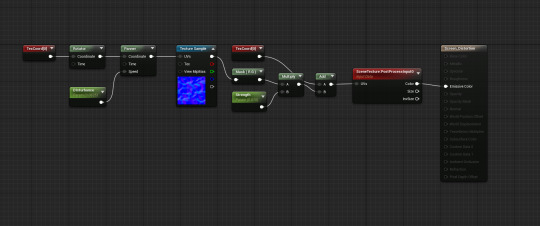
I also added a subtle screen distortion to the post processing volume which gives the screen this slight wobble effect to further help simulate the feeling of being underwater. The values can easily be changed in the blueprints which I will be changing on and off during some parts of the final animation to prevent odd looking scenes e.g. when the camera is focused on the turtle.
The screen distortion effect is only a material and it was applied to the screen by adding it as an array element to the post processing material, which means that it covers the whole screen as long as the camera is within the post process volume.
Although it isn’t really an important feature to add in the underwater scene, I really liked the effect and like the subtle impact it had but I might turn off this effect during some scenes in the cinematic, especially when the camera is focused on the sea turtle character we have since we don’t want to distort it’s shape and it might be a bit too distracting once the turtle is moving around the environment and will most likely only be kept once the turtle is off screen and the camera is just moving around the ocean. I will have to wait for Ben to finish creating an animated turtle before I can test the impact that the screen distortion material will have on the turtle, but am in no rush to do so as it is only a small, subtle effect, so I want to prioritise other more important areas first and test the bigger factors in the scene, such as the waves.
Comparison

The post processing volume’s impact on the scene is clearly shown in the image above because with it turned off, there is no connection between that image and an ocean and it looks like a completely different environment but with it on, it looks a lot more like it is set underwater, although there are still a couple of things missing like the caustics and the waves but it is a good start so far.
Fluid Dynamics/Water Physics
Waves are one of the first things you see when you are in an open body of water so in order to create a convincing underwater scene, I wanted the water plane to be one of my priorities in this project. To do this, I will need to do more in depth research about fluid dynamics and water physics to create something that’s accurate and visually appealing.
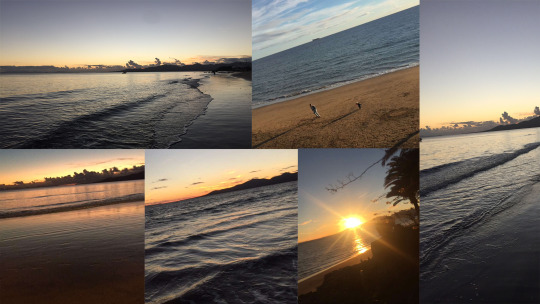
(Mia Shargill, 2018)
A friend of mine recently went to a beach in Lanzarote, Spain so I asked her to take some pictures of the beach and mainly the waves because it would be another good reference point for me when creating water planes.
https://www.youtube.com/watch?v=KPmRV1Z9ikY
https://www.youtube.com/watch?v=GRnKO1z4WZs
(Pub Games, 2014)
To create my initial water plane, I followed Pub Games’ two-part tutorial carefully, but just like I did in the previous tutorials for the water volume, I also played around with the values of the parameters in the nodes of the blueprint to see if I could create something that is more to my liking.
youtube
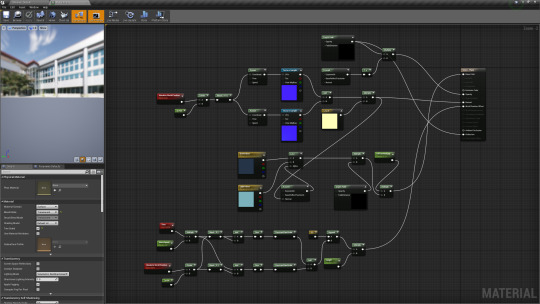
The recording above shows the water plane from my first draft. It has a spanner node in the blueprints that makes the material move from right to left. This helps it give an effect of moving water and it also has this “rise and fall” movement which can be clearly seen when up close but hard to notice when zoomed out, which improves water simulation.
The texture I am currently using is the “T_Water_N” texture from the “Water Planes” pack that is provided by Epic on the Learning Tab in the lancher and is temporary because there is something about the water plane’s texture and movement that feels a bit “off” to me, but can’t quite pinpoint which is the exact problem so it will be replaced by a different texture in the future.
Gerstner Waves
The water plane I have right now isn’t as good as I want it to be, so I looked online for more water planes to see if I could make something more convincing and realistic. I found a tutorial on YouTube and an article on Nvidia’s forum (GPU Gems) about Gerstner waves and they look much better effect than my current one, which is why I did a bit of research on this topic.
“In fluid dynamics, a trochoidal wave or Gerstner wave is an exact solution of the Euler equations for periodic surface gravity waves. It describes a progressive wave of permanent form on the surface of an incompressible fluid of infinite depth.”
(Wikipedia, 2018)

(Hailey Williams, 2017)
The image on the left shows a sine wave while the image on the right shows a Gerstner wave. A sine wave is a mathematical curve that describes a smooth periodic movement while a Gerstner wave is basically a modified sine wave, just with sharper peaks and flatter valleys and Gerstner waves are used in a lot of CG water and fluid simulations and was theorised by German-Bohemian physicist and engineer, František Josef Gerstner.
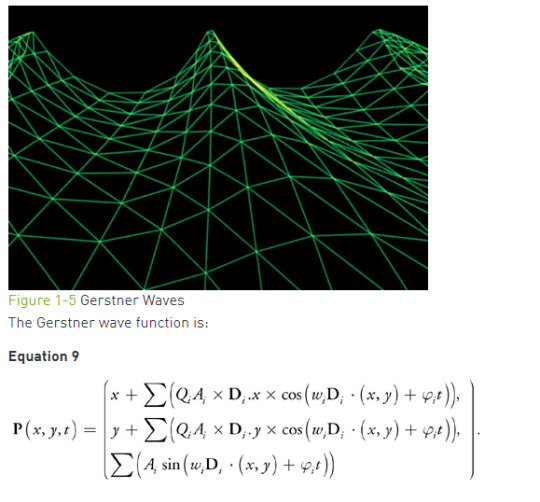
(Finch and Worlds, 2007)
There are large amounts of studies and research about Gerstner waves, fluid dynamics and water simulation that revolve around mathematics and physics and I will need to carefully study some of them, although the Math and equations that they use are very hard to understand since my background isn’t in Math, but the diagrams that they include with these equation help me understand them a bit more and I am looking for ways on how to implement these equations into an actual object.
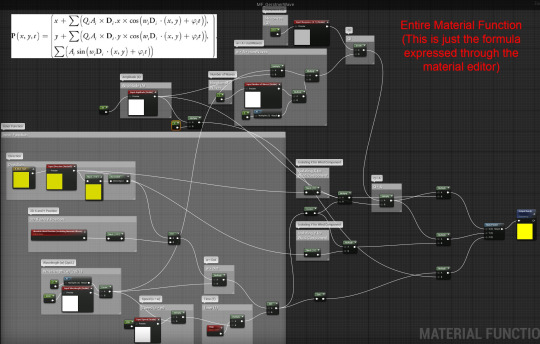
(Hailey Williams, 2017)
After looking at a number of articles and forums, I found this blueprint screenshot on how to apply the Math from the Gerstner wave equation into my project in Unreal. Williams goes step by step through the nodes and talks about how she translated the equation and created a material so I will be looking into her project closely in the future when I change my water plane into one with Gerstner waves.
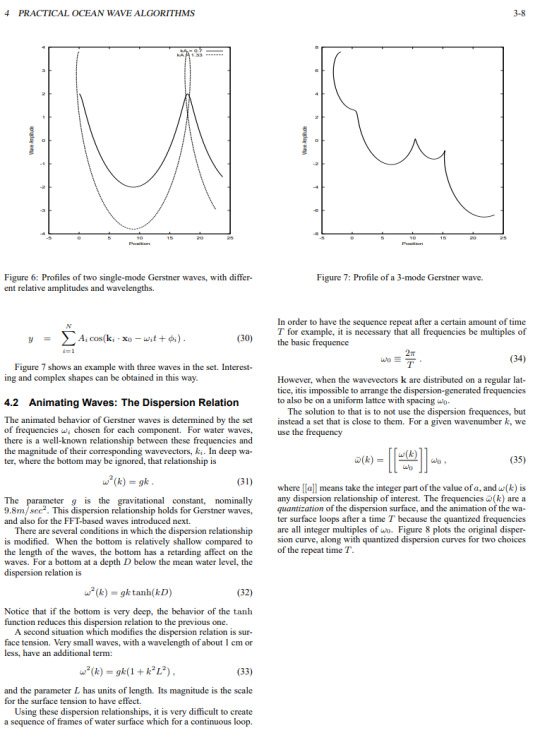
(Jerry Tessendorf, 2001)
I came accross this incredibly thorough and detailed research by Jerry Tessendorf about simulating ocean water and there in one of the pages, he talks about Gerstner waves and a similar equation is seen her and just like Williams, Tessendorf also explains the equation and splits them into parts to make it easier to understand and to tell us what each parameter means. His report also contains chapters about water volumes, caustics, god rays and Fresnel reflections (which I used in one of the nodes of my water plane material), so I will probably mention him and his research again in the next sections.
https://www.youtube.com/watch?v=OQ3D0Q5BlOs
(Ryan Brucks, 2017)
While looking more into Gerstner waves, I found this beautiful shader that Ryan Brucks created and it has a very realistic scene the way the water splashes around, the way the waves impacts the rocks and how the water moves in general. I want to achieve this level of realism in my own water plane and I hope to amaze anyone who sees my water simulation the same way I, and lots of people in the comment section on his video were amazed by his work.
https://www.youtube.com/watch?v=_y7Z0MbGOMw
(DokipenTech, 2016)
Aside from reading up on the research available online through articles, forums, documentation and more, I also want to actually create something and not just look into the theoretical side of things. To help with this, I plan on watching and recreating the Gerstner waves that YouTube user, DokipenTech has created in Unreal and like the tutorials in the post processing section, I plan on also playing around with the values of the nodes that this material will have and see if I can make any improvements and adjust everything to my liking.
Caustics
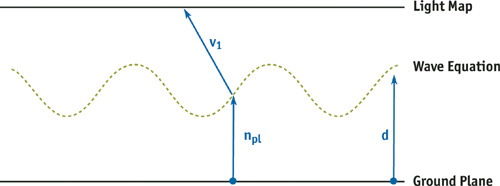
(Guardado and Sánchez-Crespo, 2007)
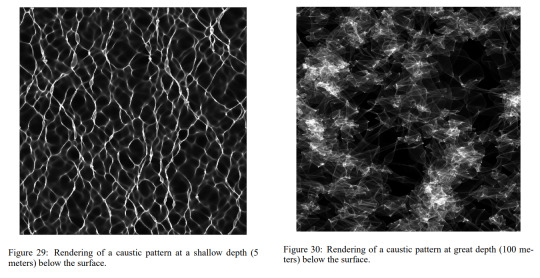
(Jerry Tessendorf, 2001)
Caustics result from light rays reflecting or refracting from a curved surface. They are these subtle white reflections and refractions of light which dance around the seafloor.
https://www.youtube.com/watch?v=e9KivVEy5Ck
(Dean Ashford, 2017)
To create the first version of my caustics, I followed the video tutorial above and the .gif below was my first attempt at creating caustics.
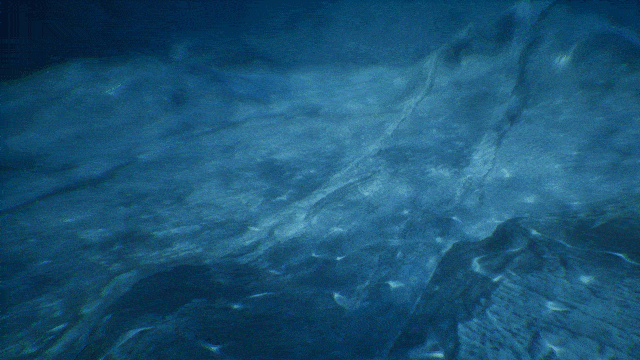
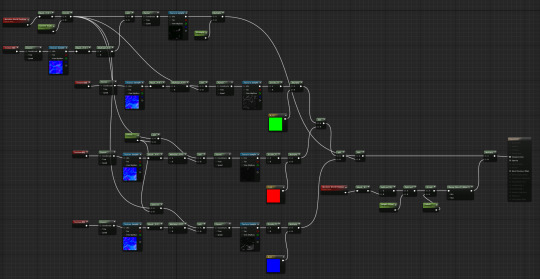
As you can see, it doesn’t look natural due to its jumpy movements, which isn’t what I wanted at all since I was imagining something that was more flowy, so I looked around for more tutorials and continued watching more tutorials of Matt Taylor as I already watched his first tutorial of a 3-part tutorial for creating an underwater scene (link: https://www.youtube.com/watch?v=W8u7GONZzoY).
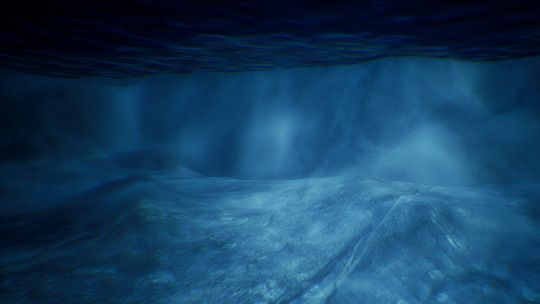
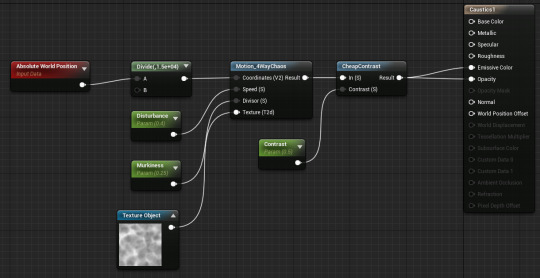
This tutorial had a much simpler code, yet it was more effective than the previous one and it is a lot smoother and more natural, which I am happy with. I have been tweaking with the values of the caustics too just like I do with every other tutorial-based material I have created to suit my scene better and the main value that I’ve been changing is the contrast and disturbance since these two parameter nodes control how “bright” the caustics are and in the image above, I think it looks a bit too “faded” and slightly unnoticeable but I concluded that it may have been due to the texture of the landscape that was causing that look and I was right because the caustics look a lot better in the improved version, which you can see later in the “Version II” section, especially in the screenshot that’s zoomed in on the sand.
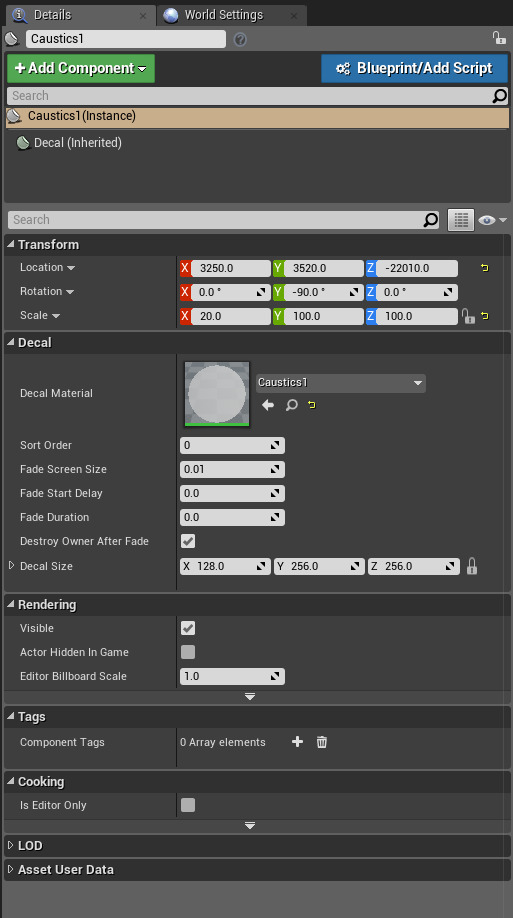
To apply the caustics, I created a deferred decal/decal actor into the scene and placed it onto the scene and it’s boundaries and what is affects can be adjusted by scaling and moving the box (similar to the volume boxes). But unlike the volume boxes, the deffered decal box doesn’t require you or the camera to be inside it’s bounds to be able to see the effects, so I can adjust its scale when the caustics are not needed in the scene - for example, the camera focuses on the turtle but we don’t want any caustics on it, so I can just lower the caustics so that it only affects the ocean floor and not the turtle.

And here you can see a slight difference between the two images if you have caustics on/off, although its only a small one here, but the caustics are much more noticeable in the newest version of the project.
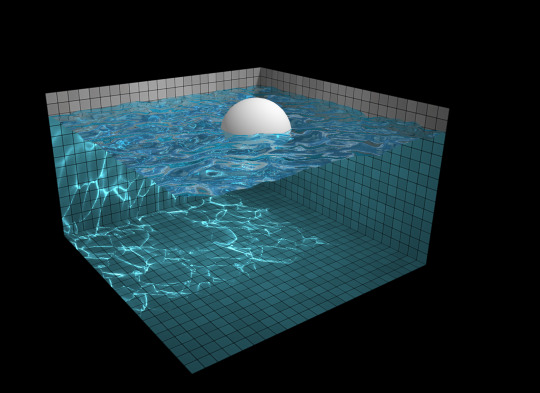
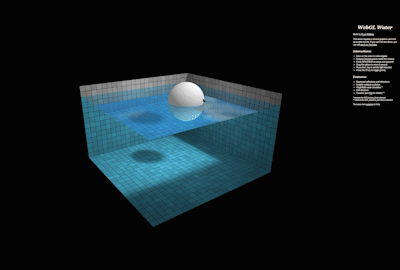
(Evan Wallace, 2011)
Above is a screenshot and a .gif from an interactive water simulation created by Evan Wallace (which can be found here: http://madebyevan.com/webgl-water/), which showcases real time fluid dynamics and caustics that adapt to the movements of the sphere that is on the water’s surface and I found this interesting because of the water plane it uses and the caustic lighting.
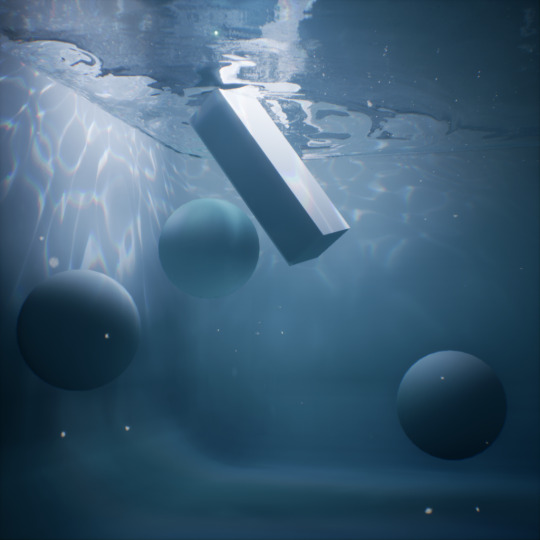
(Timothy Cole, 2017)
While doing more research and looking for inspirations and tutorials for better caustics, I came across this beautiful setup made by Timothy Cole; he created this in UE4 using materials just like I did, but his looks much better and although he doesn’t provide a step-by-step tutorial on how he created this, I will strive to replicate caustics of this quality.
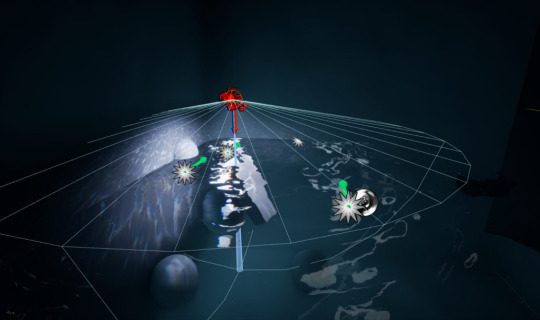
“I cheated and broke this light up into 3 lights, slightly offset from each other. Each one has the same material function, but are coloured red green and blue.”
(Timothy Cole, 2017)
His article included a video showing the caustics in motion and the movements were pretty similar to mine, but what makes his the better than mine is that his includes the minor details such as the small rainbow coloured effects that are next to the white light and I would like to mimic that same spectrum breakup and his article says how he did this, so I will be doing that same method.
Cinematics
youtube
I created lots of cinematics in Unreal last year by using the Matinee tool but since I haven’t created any in a few months, I wanted to practice by creating a short cinematic where we explore the underwater scene using two different cameras and camera angles with a quick cut in between them as a transition. I also included one of the sound effects that Sam uploaded on Basecamp.
I am very comfortable using Matinee to create cinematics since I used it a lot for Games Design Principles and Interactive Storytelling last year and have gotten good results by using it, however, the Matinee tool is old and has been a legacy tool for a while now, so I was thinking that I should learn the newer, faster alternative, Sequencer.
Sequencer notably includes the capability for users to drag and drop individual shots and change their order -- like in any other digital film editing tool. Special effects can freely be turned on and off from within the tool, even if they don't appear in the real-time game world. It also allows for multi-person workflows where different users can collaborate more easily on a single cinematic.
(Christian Nutt, 2016)
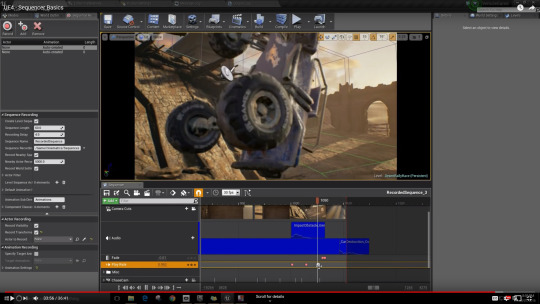
(Pub Games, 2016)
Based on a few pages I’ve read about Sequencer, it’s not too different from the Matinee tool so it shouldn’t be difficult for me to use it, but since I’ve never used it before, I will still need to watch tutorials like the one above and learn how to use this new tool. Aside from watching tutorials, I will also be reading Unreal’s overview and documentation on how the tool works and how to use it properly.
Aside from learning the technical side of how cinematics work, I will also need to study how other animators create cinematics and I immediately thought of Blizzard’s cinematics; Blizzard creates beautiful cinematics for their game trailers and I would like to achieve that level of calibre as well in my own cinematics.
https://www.youtube.com/watch?v=jSJr3dXZfcg
https://www.youtube.com/watch?v=oJ09xdxzIJQ
https://www.youtube.com/watch?v=72UbFQO5-m0
(Blizzard Entertainment, 2018)
Among are just a few of the many cinematics that Blizzard has created and they will serve as an inspiration for me, as well as research, since knowing which camera angle to use or how fast the camera is moving around the scene can be an important factor in storytelling e.g. in an emotional scene, I would need to know how close and how fast/slow to zoom in on the character’s face.
Lighting
Although Darren is the one working on the lighting, I will still be the one combining it with the other elements in Unreal and according to American cinematographer who was the director of photography at Pixar:
“Lighting is an important aspect of computer cinematography, in which lights and shadows are used to convey mood and support storytelling.”
(Sharon Calahan, 1999)
Lighting coincides with cinematics and is an important aspect when telling a story, so me and Darren might work closely together for this part of the cinematic, but of course since it’s his role, I will let him be in charge of the lighting and only intervene once adding lighting to the cinematic made in Sequencer as I’ll need his opinions on what lighting works best with the particular scene.
Ray Tracing
I recently purchased the Nvidia Geforce RTX 2070 and the main selling points of the RTX cards is that they have advanced real-time raytracing and I plan on using that technology in our animation for better lighting and shadows to improve its photorealism.
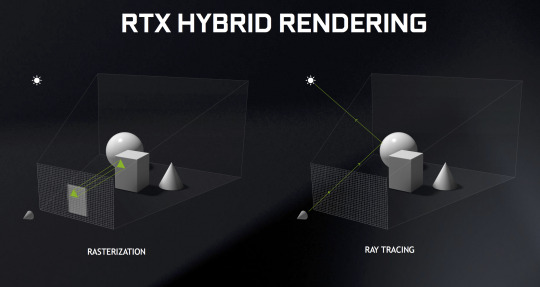
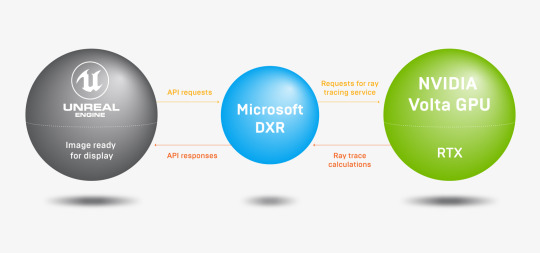
(Nvidia, 2018)
As Epic Games observes:
Renderers tend to use one of two methods for determining pixel color: rasterization or ray tracing. Rasterization starts with a particular pixel and asks, “What color should this pixel be?” Ray tracing works from the viewing angle and light sources and asks, “What is the light doing?”
Ray tracing works by tracing the path of a light ray as it bounces around a scene. Each time a ray bounces, it mimics real-life light by depositing color from earlier objects it has struck, and also loses intensity. This depositing of color makes the sharp reflections and subtle, realistic color variations that, for certain types of materials and effects, can only be achieved with ray tracing.
Because it mimics light’s real behavior, ray tracing also excels at producing area shadows and ambient occlusion. (Epic Games, 2018)
The text above explains how ray tracing works in more detail and also added images from Nvidia to visualise how ray tracing works. Although Nvidia and Epic have confirmed that Unreal Engine will be supporting RTX cards and make use of it’s tech in its next version (UE4 4.22), there is no official announcement yet for it’s release date, but there have been rumours on forums about it being planned to be released by the end of the year and once it is released, I would love to see if I could apply this to our animation and see if it makes it look more visually appealing.
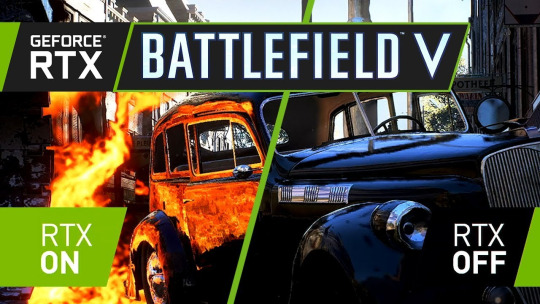
(NVIDIA GeForce, 2018)
Shown above is a comparison taken from in-game footage of RTX being used in Battlefield V and shows what ray tracing can do in a scene; to me to image on the left where RTX is on makes the scene more ‘alive’ and makes the flames seem more real due to the reflections on the car.
Version II
Since the project I showed a while ago was just the first draft and was essentially a practice run, I wanted to add a lot of improvements and give a big upgrade to the overall look of my project because the previous one wasn’t quite good enough to my liking and although it had some resemblance to an underwater scene, it certainly wasn’t clear that it was set under the ocean but more as in a lake.
I wanted to create something closer to the images I’ve seen online and those that I’ve seen in person whenever my family goes to the beach in the Philippines during summer and create something that is as realistic and as accurate that my skills and knowledge with Unreal would allow me.
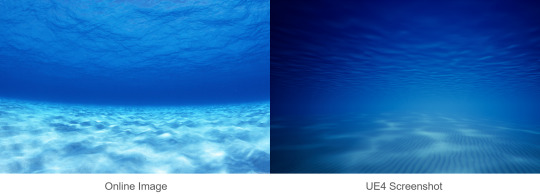
I created a whole new project using elements from my first draft, but adding improvements overall to the scene such as a better post-process volume, caustics, water plane and a newly sculpted landscape which uses a sand material that was created by Maris in Substance Painter.
I based this new scene mainly on the image on the left which was also on my mood board and tried to be as realistic and accurate as I can. I definitely preferred this new version much more than the previous one because not only was I able to create a convincing scene, it also felt like one too.
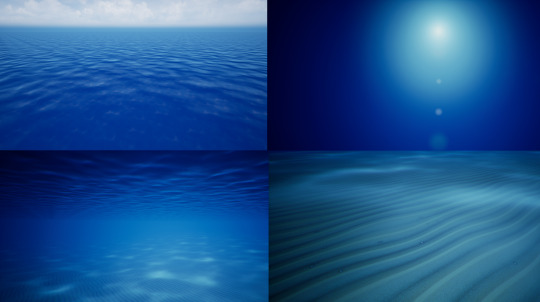
Here are some more screenshots of the current version in different angles. I have made adjustments on all the previously talked about parts (post-processing, depth of field, screen distortion, water plane, caustics) to make all of them fit in together more and work better as a whole and improve the overall aesthetic.
I plan to continue tweaking the values of the different elements in the project to further improve the looks of this project in order to create a more realistic and accurate water simulation.
Future Plans
For future work, my next step is to add the initial assets created by my group members, mainly the god rays/particle effects that Darren created as well as building the environment by adding corals/rocks that Maris created. We may also consider creating a GitHub repository in a couple of weeks as by then, my other group mates would’ve made much more content, which they may want to add into the project themselves but then be adjusted by me later on to make sure everything fits together perfectly. I plan on finishing this on December.
Aside from that, I will need to look into perhaps adding a fisheye lens and whether this effect is achievable in Unreal Engine; a fisheye lens is an ultra wide-angle lens that creates this strong distortion that is intended to produce a panoramic image. I got this idea from the image above between my screenshot and the image I found online where the online image has this slight curvature whereas mine is flat and I think adding a fisheye lens would help further improve the illusion of having a camera underwater. I also plan on finishing this on December, since I expect this to be a quick addition.
I will also need to do more research on my own work to see if there are any other effects I could add to improve my work and add more realism to create an even more convincing water simulation. The main thing I plan on doing research on is the Gerstner waves, which I discussed in depth earlier in the “Gerstner Waves” section. I plan on finishing this on January/February.
I also plan on adjusting the caustics and trying to achieve the same quality as Timothy Cole’s caustics, which I talked about earlier and will be looking around to see if there are better alternatives to what I have now. This should be finished on January too.
I will be paying close attention to the release of Unreal Engine v4.22 and for the addition of RTX support on Unreal Engine since its release is rumoured to be by the end of the year, although realistically, I wouldn’t expect it to be released until January/February next year. Once RTX support is released in 4.22, I will be installing the new version of UE4 and copy and transfer our underwater scene that we have now onto it and will be testing out the ray tracing and comparing it with our current scene in UE4 4.20 and see if there is any major difference between the two versions. If there no difference or only a small difference, then I will be keeping the current scene in version 4.20 since it won’t be worth it to spend time transferring and potentially fixing any possible bugs or incompatibility issues that may arise when using the new version of UE4 but if there is a big, noticeable difference, then I will be transferring everything onto the newer version of Unreal and fix any incompatibility issues that may come up due to them being made in an older version of Unreal. If I do go through with the transfers and the fixes for the new version, then I predict that this might take some time and may take 1-2 months to fix/finish, depending on the issues (if there are any), which will be February/March (assuming that RTX support is released in late December/early January). Although not as important as the other factors, it would still be nice to implement ray tracing into our animation for the added ‘eye candy’.
Once the animators and modellers have finished their models/animations and are ready to export as an .fbx, I will be working on implementing them into my project and putting everything together and once everything is in place, I will need to check for any errors such as missing textures or buggy animations and if I find any, I will need to try fix them and let my peers know as they may have exported it wrong or didn’t include textures, etc. Once everything is imported in Unreal and ready with no problems present, I will be ready to create the cinematics for our project and work on the camera placements/movements and ensure that we get the perfect angles for each shot of the scene and make sure that it’s appropriate for the emotions of the scene i.e. during the sad scene at the start, camera movements should be slow. I predict that these will be done by March/April, depending on the speed/workflow of the animators/modellers and any potential problems that may arise, such as the errors that I previously stated.
The deadline for this animation is on the 20th of May so I expect everything to be ready and for May, I plan on only doing the final touches to our animation, so I will be refining everything, like the values of parameters in nodes or adjusting the direction of a light slightly or fixing any last minute problems that may come up. Once everything is finished and is of good quality and everyone is happy with how it looks, it will be time to render out the animation and export it, which shouldn’t take more than a few hours since it’s only a short animation and because Unreal renders out animations quick. After the animation has been rendered, the VFX guys (Paul, Darren, Ben) may plan on doing some final touches in Nuke for post-production and apply some minor, final changes to the animation and again, render and export it afterwards for submission.
Overall, I am very happy with my progress and of course the whole group’s progress so far. At this rate, we would be able to create an amazing final animation with a more realistic underwater scene and characters and will be looking forward to the final piece.
Feedback
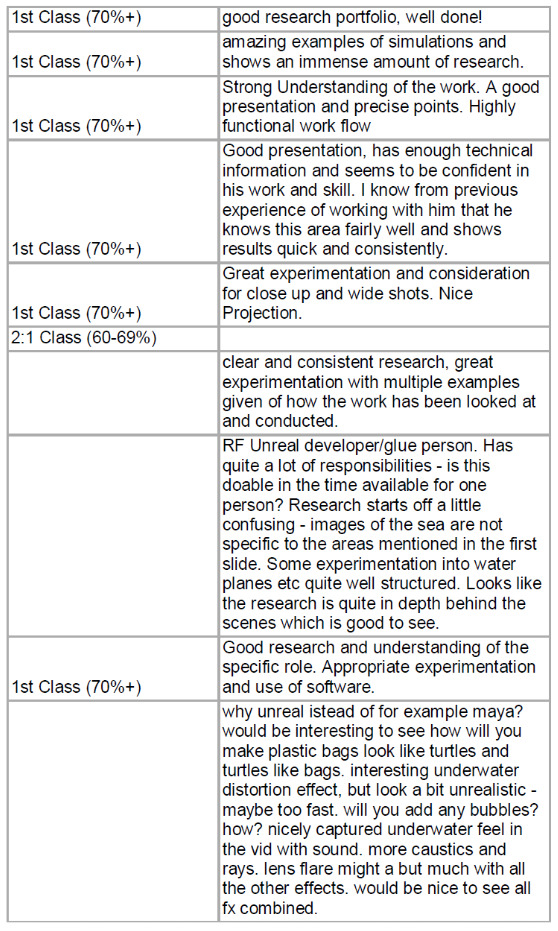
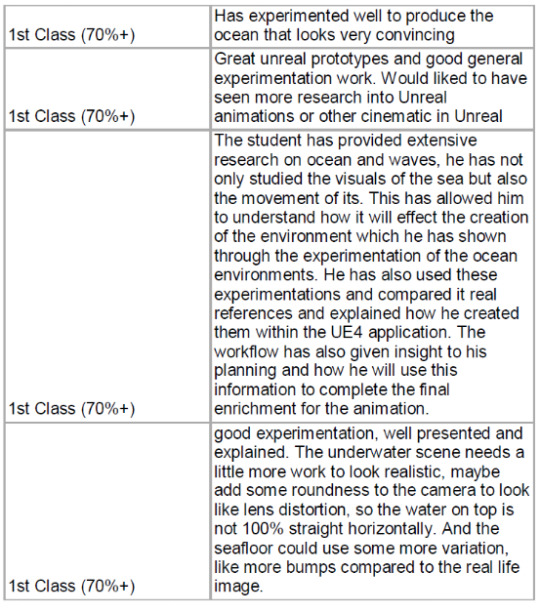
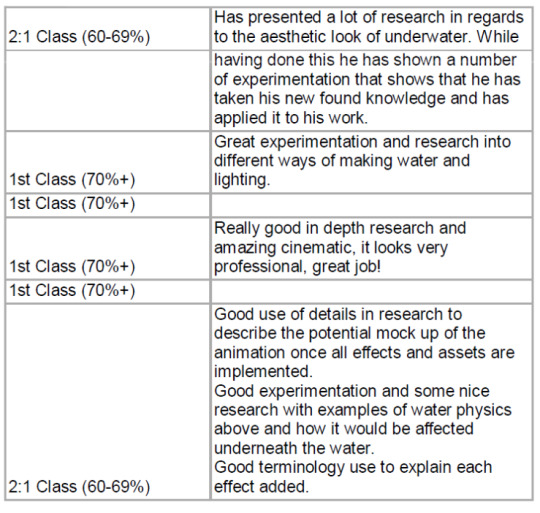
We had presentations this week where we talked about our roles and contributions to the group and showcasing any experimentations we had in front of the class and I received some valuable feedback that have given me some ideas on any improvements I can make. Although most of the feedback I have received from my peers were praises, some of them were suggestions and questions, which I will address below.
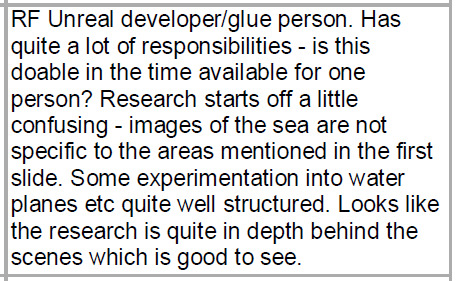
First comment I will be addressing is Ryan’s feedback since his was the first one that asked a question. To answer the first question, yes, I do believe this is all doable for me to create within the time frame we are given since I am already familiar with Unreal Engine and I am very comfortable with the software and also enjoy using the software. Based on what I’ve done so far, I am already making good progress and am already at a good level in terms of building the scene since as of now, I have already created something that is a convincing underwater scene, upon which both my teammates and most of the class have agreed with, but of course, there are still lots of places that could be improved and that would require further research and experimentations. To answer the second question/sentence, I almost always create a moodboard during the brainstorming part of the project in the early stages since it gives me ideas on what I can do and how things will look, but I may not have explained it well, which is why it might have been confusing.
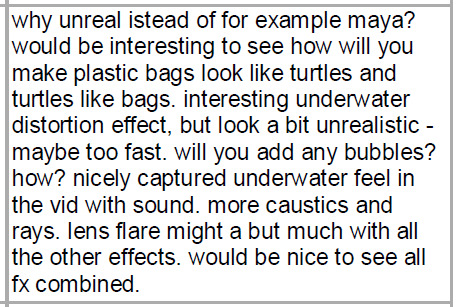
This was a very good question and I should’ve added a slide in the powerpoint and explained why we chose UE4 instead of other animation packages. One reason on why we chose to use Unreal instead of other software for rendering the animation is because we were using multiple different softwares - Ben was using Blender to sculpt, rig and animate his model while Maris was using Cinema 4D to model his environment and Substance Painter to texture them and Callum, I believe, used 3ds Max to model his props, so I suggested that we try using Unreal Engine to put all these models/animations/materials/etc together created in a handful of different packages because by doing it in this way, we were all using software that we are most comfortable with instead of, for example, Ben compromising and using Maya to animate even though he is much more comfortable animating in Blender just to fit in with Ed’s animation in Maya to make everything streamlined due to everything being only in one piece of software. By creating using Unreal, we are able to keep everything streamlined but not need to make compromises as to what software to use as you can just export the models as an .fbx and import them into Unreal and work from there.
Another reason on why we chose to use Unreal Engine was that after I “sold” the idea of using UE4 to my group, we told Ryan about it and he informed us that it is an interesting idea to use Unreal instead of the usual animation packages and he also said that some studios are actually starting to use Unreal when creating TV shows and other animations so it may be a good idea to use Unreal now because if the industry moves towards that direction of primarily using Unreal for animations, it would be good for “future-proofing” as we could use this animation as part of our portfolio to show those companies that we have experience in animating in Unreal when looking for a job and since we’ve already used it beforehand to create an animation, we would have an upper hand over other potential animators since they might need to learn this software from scratch whereas we already know how to. It is also good to expand our knowledge of different software knowledge since artist need to be flexible and learn to adapt to any changes in the industry in the future because if you only know how to use one software now and it becomes redundant in the future and you are unable to adapt and learn the new software that everyone is using, you would have a really hard time finding a job in that field.
What Ryan said about the studios starting to use Unreal for creating TV shows interested me since I really enjoy using Unreal and would love to continue working on using it after we graduate. I haven’t heard of any studios using UE4 to create TV shows before so I searched online for studios that use Unreal and I found an article about a Pakistan-based studio, 3rd World Studios, creating the first ever animated feature film that was rendered entirely in Unreal Engine which is titled “Allahyar and the Legend of Markhor” (trailer: https://www.youtube.com/watch?v=162VCDUndT0). This is proof that despite Unreal Engine being a games engine, it can also be used outside games and create a film, just like 3rd World Studios did.
“Unreal has saved us months and months of rendering time. On average in a traditional pipeline, film quality renders take around 3-4 hours per frame and depending on the scene’s complexity this time can increase exponentially. In UE4, we never worried about render times.”
(3rd World Studios, 2018)
The article was an interesting read as the writer interviewed the studio on how and why they used Unreal and what benefits it provides and the studio said something that I forgot to mention before; when I finished creating a short test cinematic, the render times were much quicker in Unreal compared to other 3D packages and it will save us a lot of time once we have put together everything in Unreal and start the rendering process.
To answer the distortion comment, the video that I used to show the distortion effect was from the previous version of the project and I also bumped up the values on the speed slightly as I was worried that it might be too subtle when presented on the big monitors so I wanted to ensure that they were noticeable. The screen distortion effect looks much better in the newest and current version of the project (same one as the version that’s in the “Version II” section) and is a lot less fast/strong as it was on the presentation. As for the bubbles question, those would be particle effects, which is what Darren is working on and he also presented it, so the commenter might have missed that slide when he was presenting it. Caustics are on a decent level but I want to try create a better one if possible so I will continue working on that too and playing with the values and also do a bit more research online to see if there is a better alternative with a nice look. Finally, the lens flare is still a work in progress and was still in the early stages so I will tone that down a bit as I agree that it was a bit strong.

I didn’t include it in my presentation but like I said in the “Cinematics” section above, I will be doing research on the other types of cinematics that Unreal offers, especially the Sequencer since Matinee has been a legacy tool for a while now, so it’s an old method and 3rd World Studios also used Sequencer in making their film in Unreal.
“The latest version Sequencer is faster and more stable than ever and proved to be a lifesaver as we approached the end of our film’s production.”
(3rd World Studios, 2018)
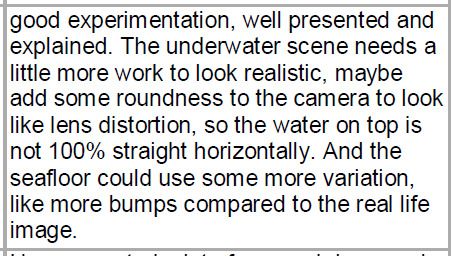
I agree with this comment; the scene definitely needs more work to make it look more realistic and I am planning to achieve that roundness effect in the future which is similar to the fisheye lens that cameras have, but I will need to do research on this as I am unsure whether or not this is doable in Unreal, which I talked about more in the “Future Plans” section of this portfolio. The current seafloor isn’t the final product yet and I agree that the seafloor does need more variation, so I am planning to sculpt the landscape more to create some bumps to add some variation and prevent it from looking too flat.
Reference
Mood Board
Divetech, Inc. (2016). Mood Board Image #3. [image] Available at: http://divetechhouston.com/underwater-ocean/ [Accessed 16 Nov. 2018].
Natural Capital Coalition (2018). Mood Board Image #2. [image] Available at: https://naturalcapitalcoalition.org/the-value-of-seagrass-in-securing-a-sustainable-planet/ [Accessed 16 Nov. 2018].
Notre-Planete (2013). Mood Board Image #4. [image] Available at: https://www.notre-planete.info/actualites/3655-salinite_ocean_rechauffement_climatique [Accessed 16 Nov. 2018].
Science Daily (2018). Mood Board Image #6. [image] Available at: https://www.sciencedaily.com/releases/2018/01/180125140848.htm [Accessed 16 Nov. 2018].
Unsplash (2017). Mood Board Image #7. [image] Available at: https://unsplash.com/photos/Ok7iNxjmQ1A [Accessed 16 Nov. 2018].
Wallpapers Mug (2018). Mood Board Image #8. [image] Available at: https://wallpapersmug.com/w/wallpaper/sea-waves-calm-horizon-5k-255c5f [Accessed 16 Nov. 2018].
World Wildlife Fund (WWF) (2018). Mood Board Image #1. [image] Available at: https://www.worldwildlife.org/pages/in-nuarro-mozambique-a-partnership-for-people-and-oceans [Accessed 16 Nov. 2018].
World Wildlife Fund (WWF) (2014). Mood Board Image #5. [image] Available at: http://wwf.panda.org/wwf_news/?216410/Satellite-tracking-identifies-risk-zones-for-leatherback-turtles [Accessed 16 Nov. 2018].
Online
Allahyar and the Legend of Markhor. (2018). [film] Directed by U. Khan. Pakistan: 3rd World Studios.
Blizzard Entertainment (2016). Overwatch Animated Short | “Dragons”. [video] Available at: https://www.youtube.com/watch?v=oJ09xdxzIJQ [Accessed 16 Nov. 2018].
Blizzard Entertainment (2017). World of Warcraft: Battle for Azeroth Cinematic Trailer. [video] Available at: https://www.youtube.com/watch?v=jSJr3dXZfcg [Accessed 16 Nov. 2018].
Blizzard Entertainment (2018). Warcraft III: Reforged Cinematic Trailer. [video] Available at: https://www.youtube.com/watch?v=72UbFQO5-m0 [Accessed 16 Nov. 2018].
Calahan, S. (1999). Storytelling through Lighting: A Computer Graphics Perspective. [ebook] Pixar. Available at: http://www.cmiresearch.org.uk/uploads/2/8/9/0/28906783/storytelling_through_lighting.pdf [Accessed 16 Nov. 2018].
Cole, T. (2017). Working with Underwater Caustics in Real-Time. [online] 80.lv. Available at: https://80.lv/articles/working-with-underwater-caustics-in-real-time/ [Accessed 16 Nov. 2018].
Cowley, D. (2018). Visually Stunning Animated Feature ‘Allahyar and the Legend of Markhor’ is the First Produced Entirely in Unreal Engine. [online] Unreal Engine. Available at: https://www.unrealengine.com/en-US/developer-interviews/visually-stunning-animated-feature-allahyar-and-the-legend-of-markhor-is-the-first-produced-entirely-in-unreal-engine [Accessed 16 Nov. 2018].
Dean Ashford (2017). UE4 - Tutorial - Underwater and Caustics Part 1. [video] Available at: https://www.youtube.com/watch?v=5a0w3gcdtKg [Accessed 16 Nov. 2018].
Demers, J. (2007). Depth of Field: A Survey of Techniques. [online] NVIDIA Developer. Available at: https://developer.nvidia.com/gpugems/GPUGems/gpugems_ch23.html [Accessed 16 Nov. 2018].
DokipenTech (2016). Unreal Engine 4 Gerstner Waves Livestream. [video] Available at: https://www.youtube.com/watch?v=_y7Z0MbGOMw [Accessed 16 Nov. 2018].
En.wikipedia.org. (2018). Trochoidal wave. [online] Available at: https://en.wikipedia.org/wiki/Trochoidal_wave [Accessed 16 Nov. 2018].
Finch, M. and Worlds, C. (2007). Effective Water Simulation from Physical Models. [online] NVIDIA Developer. Available at: https://developer.nvidia.com/gpugems/GPUGems/gpugems_ch01.html [Accessed 16 Nov. 2018].
Gamedev1909 (2015). Water volume and Effects Tutorial Unreal Engine 4. [video] Available at: https://www.youtube.com/watch?v=Gr5BDGahdEA [Accessed 16 Nov. 2018].
Guardado, J. and Sánchez-Crespo, D. (2007). Rendering Water Caustics. [online] NVIDIA Developer. Available at: https://developer.nvidia.com/gpugems/GPUGems/gpugems_ch02.html [Accessed 16 Nov. 2018].
Matt Taylor (2016). Unreal Engine 4 - Water Caustics (Faking Light On the Bottom). [video] Available at: https://www.youtube.com/watch?v=W8u7GONZzoY [Accessed 16 Nov. 2018].
Matt Taylor (2016). Unreal Engine 4 Water Volume With Bubbles Walk Through. [video] Available at: https://www.youtube.com/watch?v=n5UKw_Crlr4 [Accessed 16 Nov. 2018].
Nutt, C. (2016). Unreal Engine 4's new Sequencer allows for film-style cinematic workflow. [online] Gamasutra.com. Available at: http://www.gamasutra.com/view/news/268236/Unreal_Engine_4s_new_Sequencer_allows_for_filmstyle_cinematic_workflow.php [Accessed 16 Nov. 2018].
NVIDIA Geforce (2018). Battlefield V: Official GeForce RTX Real-Time Ray Tracing Demo. [video] Available at: https://www.youtube.com/watch?v=WoQr0k2IA9A [Accessed 16 Nov. 2018].
NVIDIA. (2018). NVIDIA GeForce RTX. [online] Available at: https://www.nvidia.com/en-gb/geforce/20-series/rtx/ [Accessed 16 Nov. 2018].
Pub Games (2014). UE4 - Interior Water #1. [video] Available at: https://www.youtube.com/watch?v=KPmRV1Z9ikY [Accessed 16 Nov. 2018].
Pub Games (2014). UE4 - Interior Water #2. [video] Available at: https://www.youtube.com/watch?v=GRnKO1z4WZs [Accessed 16 Nov. 2018].
Pub Games (2016). UE4 - Sequencer Basics. [video] Available at: https://www.youtube.com/watch?v=rn6l_69cvu0 [Accessed 16 Nov. 2018].
Ryan Brucks (2017). No particles. Gerstner Wave shader + analytical splashes. [video] Available at: https://www.youtube.com/watch?v=OQ3D0Q5BlOs [Accessed 16 Nov. 2018].
Shargill, M. (2018). Playa La Peña Grande. [Photo] Tías, Lanzarote, Spain.
Tessendorf, J. (2001). Simulating Ocean Water. [ebook] pp.4-8. Available at: http://www-evasion.imag.fr/Membres/Fabrice.Neyret/NaturalScenes/fluids/water/waves/fluids-nuages/waves/Jonathan/articlesCG/simulating-ocean-water-01.pdf [Accessed 16 Nov. 2018].
Taylor, M. (2016). Unreal Engine 4 Water Volume With Bubbles Walk Through. [video] Available at: https://www.youtube.com/watch?v=n5UKw_Crlr4&list=PLogcsc-QeymRPyqOUFy06DjdDst1J-L2q&index=1 [Accessed 16 Nov. 2018].
Unreal Engine Documentation. (2018). Sequencer Overview. [online] Available at: https://docs.unrealengine.com/en-us/Engine/Sequencer/Overview [Accessed 16 Nov. 2018].
Unreal Engine. (2018). Technology Sneak Peek: Real-Time Ray Tracing with Unreal Engine. [online] Available at: https://www.unrealengine.com/en-US/tech-blog/technology-sneak-peek-real-time-ray-tracing-with-unreal-engine [Accessed 16 Nov. 2018].
Wallace, E. (2011). WebGL Water. [online] Madebyevan.com. Available at: http://madebyevan.com/webgl-water/ [Accessed 16 Nov. 2018].
Water Plane Texture. (2015). [Texture, Digital] Water Planes, Epic Games.
Williams, H. (2017). Tutorial: Ocean Shader with Gerstner Waves. [online] 80 Level. Available at: https://80.lv/articles/tutorial-ocean-shader-with-gerstner-waves/ [Accessed 16 Nov. 2018].
0 notes
Text
Reflection
Hierarchy was fundamental and was used frequently in my Portfolio. The visual hierarchy was apparent in all the designs in each page as the work was the main focal point with the type supporting it. It was designed this way so that people would connect with the image and design first and then be drawn to the text.
Throught the development of my portfolio and completed a lot of experimentation with the hierarchy of the type so that there is a distinction between the titles and the body text.
Clear and conventional typography was used throughout the portfolio as I wanted to avoided the typography clashing with the actual design work. The type I used needed to be simple and easy to read. I avoided decorative elements as this can distract the viewer from what is important. I kept my layouts minimalistic and decluttered so that my projects would be the key features
Usual is a sans serif typeface which is modern but can be neutral. It is easy to read because it is slightly condensed. It is simple so that the viewer will not be distracted. Usual has 5 weights and works well across a wide range of body sizes from headings to body text. I alot of my projects involved me showcasing my typographic skills so did not want the font I used to present my portfolio to compete with this.
I have aligned all the text in each of the layouts in a grid format so as the viewer scrolls down my portfolio there is a strong sense of cohesion. Another cohesive element was that for each page, the block of text was on the opposite side of the page from the previous one. I also aligned the text to either the top or bottom of each page. I was not afraid to use white space as I fell there is no need to always fill up the page. This gives the viewer time to take in what has been presented as well as the opportunity to draw the viewer in to the text.
My biggest influence through reserach was the chapter of No Plastic Sleeves by Volk and Currier where I learnt a lot about what to include and what not to include in portfolios. The most important lesson from their book was that you should showcase only your very best work and to omit anything that is repetitive. Having too many projects in your portfolio can be very offputting. I originally had a lot more so it was an essential learning for me as it then gave me a fresh perspective to go back and cut the pages I did not really need. After careful deliberation, I selected 5 projects that showcased key skills that I have.
Point of difference and variety was very important to me for structuring my portfolio as I wanted each project to stand alone and showcase each of the design skills I have. I also wanted to honour each individual project as each of them were important to me and all I had a personal connection with. This gave the projects the edge against others as well as the opportunity to showcase my skills.
Overall my work Kaupapa is essential and the core essence of my process and design style. I will always find some way to connect with my projects which is what adds the depth to my work. This is the element I want to portray and any potential employer will be able to see this. They are seeing a piece of me as well as the skills I have and would consider me as a potential asset to their company.
0 notes
Text
Impact of COVID-19 on Vaccine in Healthcare Industry | Data Bridge Market Reserach

COVID-19 Impact on Vaccine in Healthcare Industry
OVERVIEW
The COVID-19 has posed a complex challenge in front of different biotech companies, which has badly impacted the worldwide market. However, it has boosted the growth of companies involved in vaccine development, as there is great need of vaccine which can act against coronavirus and prevent this deadly disease.
Along with COVID-19 vaccines, there are various kinds of vaccines which are administered to people of different age groups in order to prevent them from different kinds of infectious diseases. These vaccines manufacturing process and administration process has been affected due to limited access to healthcare facilities and fear of getting COVID-19 infections.
For instance,
· In July 2020, around 80 million children who are under the age of one year have been reported to face some kind of disturbance mainly because of limited healthcare facilities access and threat of getting COVID-19 infections.
· In July 2020, WHO and UNICEF warned against the rapid decline in the number of children who have received life-saving vaccines and had stated that all this has happened due to disruptions in uptake and delivery of immunization services as a result of COVID-19 pandemic.
COVID-19 disease is a major threat to people who already have existing medical complications such as diabetes, pneumonia, and tuberculosis among others. This thus enhances the people attention towards preventing themselves from such infectious disease so that the chances of getting COVID-19 infection reduce.
As the prevalence of infectious disease is increasing worldwide, it has become important to provide patients with proper vaccination during the prevailing pandemic of COVID-19, this is the reason why biotech companies and government are taking several steps in order to deal with cumbersome conditions.
PRICE IMPACT:
As no treatment has been discovered yet for coronavirus, the fear of getting infection led the people to remain safe at their home, as a result of which various businesses around the world are suffering a lot involving biotech companies among others.
Various companies are working on vaccine development process, on other hand, several companies have signed deals with government of other countries in order to reserve their vaccine distribution, so as to earn benefit.
The cost of COVID-19 vaccines is likely to decrease due to high concern towards remaining prevented from deadly infectious diseases even during such a pandemic.
For instance,
· As per the news of 2020, Moderna Inc., a company recently working on mRNA-1273 vaccine which will act against the deadly coronavirus, stated that it will provide its vaccine at a cost of USD 32.00 to USD 37.00 to public.
· According to the news of August, 2020, Pfizer Inc. has signed an agreement with government to provide 100 million doses of coronavirus vaccine at a cost of USD 1.95 billion. This agreement will allow government to access coronavirus vaccine at a cost of USD 20.00 per dose.
Moreover, increasing prevalence of COVID-19 all around the world is also responsible for increasing the demand of COVID-19 vaccines at low cost.

All these factors thus signifies that increasing cases of COVID-19 led to the enhanced concern for government authorities and many other healthcare organizations towards the welfare of country people. This concern allowed the vaccine manufacturing companies to sign deal for vaccines at lower costs.
Thus, COVID-19 impact has expected to decrease the price of vaccines in the market.
IMPACT ON DEMAND
The coronavirus has affected the various regions of the world and caused widespread closure of companies and local manufacturing plants. This lockdown and isolation has adversely impacted the global economic activity.
Surge in COVID-19 cases is expected to enhance the number of deaths caused by HIV, tuberculosis and malaria. This concern puts a major emphasis over the need of vaccination.
In order to prevent tuberculosis and malaria among many more diseases, children are provided with vaccination.
The demand of vaccination has decreased due to several reasons which include fear of parents towards their children health which makes them not to take them to clinics and other government organizations in order to receive effective vaccination.
Moreover vaccine administrators have also been diverted from their responsibility, as they are scared of coronavirus.
Lack of protective equipment is one of the other major reason which poses challenge in front of physicians to treat a large number of people.
This signifies that increasing fear among people led to few vaccinations in 2020 which demonstrates the decrease in vaccine demand for various types of infectious diseases except COVID-19 due to prevailing coronavirus infections.
IMPACT ON SUPPLY
Due to pertinacious COVID-19 lockdown, sanctions have been imposed by governments of various countries. These restrictions and barriers across countries borders led to a decrease in supply of vaccines across the borders.
As per the report published by UNICEF on June 2020, it has been stated that in week of March 22nd, a collapse has been taken place in airline industry which has adversely impacted the shipment of vaccines. The report also suggested that currently the improvement in airline and shipments is increasing but up to a limited extent.
Due to supply disruption of vaccines, the countries across West and Central Africa, East and Southern Africa, East Asia and South Asia had reported that the vaccine stocks of their countries has reached to critical levels, these includes various types of vaccines involving pentavalent (diphtheria, tetanus, pertussis (whooping cough), bacillus calmette-guérin (BCG), hepatitis B and haemophilus influenza (type b), rotavirus and pneumococcal conjugate vaccine (PCV).
Moreover, UNICEF, WHO and GAVI had reported suspension of their vaccination programs due to delay in shipments.
For instance,
· In July 2020, a new published entitled “COVID-19 Disrupted Pneumococcal Vaccine Procurement, MOH Still Working On Supply”, this has been depicted that pandemic of COVID-19 has led to delay in the procurement process of pneumococcal vaccine which can be proved to be a cause of rising pneumococcal infection to vast children population present worldwide.
· In May 2020, a total of 99 countries have been reported the delay of immunization program due to inefficient vaccine supply because of constant lockdown.
· In May 2020, World Health Organization (WHO) warned about the risk to millions of children which are unable to get routine vaccination just because of the prevailing COVID-19 pandemic all over. This healthcare organization suggested that lockdowns and cutbacks in commercial flights have led to delayed supply of vaccines, which is one of the major factors responsible for children not achieving proper vaccination.
This thus signifies that due to continuous lockdown and several restrictions by government authorities, the companies and patients are facing disruption of supply chain for various kinds of vaccines. Moreover, delay in vaccine supply leads to extreme loss to vaccine manufacturing companies because of vaccine expiry during such a long term period.
STRATEGIC DECISIONS OF MANUFACTURERS
Collaboration, agreements, strategic initiatives by market players such as Novartis AG, AstraZeneca and Vaxxas among others in the vaccine market will help them to expand their product portfolio and to provide with the most innovative and appropriate vaccine involving COVID-19 vaccine to physicians and patients. This in turn will lead to increasing product sales and hence will put a positive impact on overall company’s revenue.
Vaccine manufacturing companies are taking so many strategic decisions in order to cope up with the current scenario of COVID-19. The companies engaged in manufacturing of vaccines are collaborating so as to accelerate the development of various kinds of vaccines.
The companies have already taken several kinds of strategic initiatives in order to cope up with the corona virus situation.
For instance,
· In August 2020, European Commission has signed an agreement with AstraZeneca, a pharmaceutical company for purchase of COVID-19 vaccine. As per the agreement, the commission will purchase 300 million diseases of COVID-19 vaccines from AstraZeneca. This initiative helped the company to earn more benefit and to enhance its overall revenue.
· In July 2020, Vaxxas went under partnership with Merck and Harro Hofliger with an aim to commercialize its HD-MAP technology, used for vaccine delivery via nanopatch, a needle free vaccine delivery technology. Through this partnership, the company has received USD 18.00 million from Merck, which helped it to boost up its vaccine development procedure.
· In June 2020, Novartis AG went under partnership with Massachusetts Eye and Ear General Hospital for producing a novel vaccine against the coronavirus. As per the deal, AveXis will provide with its expertise and technology needed for vaccine development procedure. This initiative has helped the company to enhance its platform with the addition of new coronavirus vaccine in its product portfolio.
· In April 2020, AJ Vaccines received pre-qualification for Picovax, an inactivated polio vaccine from WHO. This initiative helped the company to boost its product portfolio amid COVID-19 against the most threatening polio disease.
· In March 2020, CureVac has signed a deal with the U.S. President Donald Trump for development of CoV vaccine by utilizing its mRNA platform. This initiative helped the company to raise its potential for vaccine development.
· In March 2020, Inovio Pharmaceuticals Inc. received USD 5.00 million from Bill & Melinda Gates Foundation for accelerating the manufacturing process of CELLECTRA 3PSP proprietary smart device for delivery of COVID-19 vaccine.
With the increasing demand of effective COVID-19 vaccines, the urgent need of COVID-19 vaccine among other vaccines is increasing which is responsible for fueling up the growth of the vaccine market.
Thus, the companies operating in the vaccine market are adopting several strategies including collaboration, agreements, partnership and market expansion to enhance their business. These strategic decisions by the companies are expected to provide significant opportunities for the market players operating in the vaccine market.
CONCLUSION
The pandemic of COVID-19 has resulted in several restrictions throughout the borders which led to decline in vaccine stocks, such as vaccines for polio, tuberculosis among others. However, the urgent demand of COVID-19 vaccine allowed the manufacturers to boost up their vaccine manufacturing activities, which allows them to compensate their decline of revenue. Moreover, various kinds of strategic initiatives taken by market players also helped them to make a constant position in the vaccine market.
#Vaccine Market#Vaccine Market Analysis#Vaccine Market Analysis in Developed Countries#Vaccine Market by Application#Vaccine Market by Type#Vaccine Market Development#Vaccine Market Forcast#Vaccine Market Future Innovation
0 notes
Text
Beer Market – Size, Share, Outlook, and Competitive Analysis, 2018–2026

Beer is the most widely consumed alcoholic drink across the world. This drink is generally brewed from cereal grains such as maize, rice, and wheat. Moreover, beer is brewed with hops that adds bitterness, stability, and flavor to the beer. Other flavoring agents such as herbs, fruits, and gruit can also be added instead of hops.
Download PDF Brochure OF Reserach Report @: https://www.coherentmarketinsights.com/insight/request-pdf/1440
The growth of this market is attributed to rise in consumer preference for beer over other alcoholic drinks. According to the World Health Organization (WHO), in 2016, beer accounted for around 36% of the total alcohol consumption. This is further attributed to high consumption of beer among young people. Therefore, major players are focusing on launching new products to meet the rising demand. For instance, in 2018, MillerCoors Company, introduced a new light beer line named Two Hats, which features the pineapple and lime flavors, targeting the young population.
However, high excise duties and taxations on imported and local beer are key factors restraining growth of the global beer market. For instance, for imported beer in Switzerland, an individual subjected to customs is liable to pay beer excise tax, which includes US$ 17.85 per hectoliter of light beer, US$ 26.78 per hectoliter of regular beer, and US$ 35.71 per hectoliter of strong beer. Moreover, rising health concerns among the populace is expected to further restrain the growth of global beer market.
For More Information @: https://www.coherentmarketinsights.com/ongoing-insight/beer-market-1440
Global Beer Market Outlook:
Asia Pacific region dominated the global beer market in 2016 and is expected to retain its dominance over the forecast period. This is due to the increase in expenditure and changing lifestyle of people in this region. India and China are projected to be the growth engines in the region. In 2017, B9 Beverages Pvt. Ltd. expanded its beer portfolio by launching two variants namely; Bira 91 Light and Bira 91 Strong in India. Bira 91 light, is one of the low calorie alcoholic beverage having calorie lower than a glass of breezer, cocktails or champagne. Bira 91 strong is a high intensity wheat beer having 7% alcohol, as large portion of beer sold in India is strong having more than 5% alcohol.
About Coherent Market Insights:
Coherent Market Insights is a prominent market research and consulting firm offering action-ready syndicated research reports, custom market analysis, consulting services, and competitive analysis through various recommendations related to emerging market trends, technologies, and potential absolute dollar opportunity.
Contact Us:
Mr. Shah
Coherent Market Insights
1001 4th Ave,
#3200
Seattle, WA 98154
Tel: +1-206-701-6702
Email: [email protected]
0 notes
Text
FPIs net buyers in first half of March driven by positive global cues; invested Rs 20,418 cr in capital markets
FPIs net buyers in first half of March driven by positive global cues; invested Rs 20,418 cr in capital markets
[ad_1]
New Delhi: Overseas investors poured in more than Rs 20,400 crore in the domestic capital market in the first half of March, mainly driven by positive global cues.
The expectation of a positive outcome from the US-China trade agreement along with US Fed’s decision to put rate hike on hold, have worked in favour of entire emerging market…
View On WordPress
#analyst merger reserach#capital market#domestic concerns#Economic growth#emerging market segment#Fed#Foreign Portfolio Investors#FPI trend#FundsIndia#Global cues#investors#NewsTracker#US China trade agreement
0 notes
Text
HLA Typing for Transplant Market Major Manufacturers, Trends, Demand, Share Analysis to 2023
Global HLA Typing for Transplant Industry
New Study On “2018-2023 HLA Typing for Transplant Market Global Key Player, Demand, Growth, Opportunities And Analysis Forecast” Added To Wise Guy Reports Database
HLA Typing transplant Market is an efficient method of matching the tissues of the potential donor with the recipient of the respective tissues. It determines antigens on the white blood cells, which resolves the compatibility of the tissues for the organ transplantation. HLA typing is an important procedure used in the transplantation of stem cells, kidney, liver, pancreas, heart transplant, and bone marrow. Increasing number of transplantation procedures owing to rising number of organ failures is the major factor driving the growth of the HLA Typing. Moreover, the increasing geriatric population and growing awareness among population regarding the importance of organ donation are some of the factors propelling the growth of the global HLA Typing. The high cost of typing devices and stringent reimbursement policies are some factors limiting the growth of the global HLA Typing. However, the improvement in healthcare sector in emerging economies such as China, and rising demand for low-cost DNA sequencing technology is likely to fuel the market growth in the near future.
Try Sample Report @ https://www.wiseguyreports.com/sample-request/3271382-global-hla-typing-for-transplant-market-research-and-forecast-2018-2023
The HLA Typing can be segmented on the basis of technology, product & services, application, and end user. Based on technology, the market can be diversified into non-molecular assays and molecular assays. Non-molecular assays can be further segmented into serological assays and mixed lymphocyte culture assays. Moreover, the molecular assays segment can be further segmented into PCR-based molecular assays and sequencing-based molecular assays. The PCR-based molecular assays are further dub-segmented into sequence-specific primer (SSP-PCR), sequence-specific oligonucleotide (SSO-PCR), sequence-based typing (SBT-PCR), and reference strand-based conformation analysis (RSCA-PCR). The sequencing-based molecular assays can be further sub-segmented into Sanger sequencing and next-generation sequencing. Based on product & services, the market is bifurcated into reagents, software, and instruments. Based on applications, the market is segmented into diagnostics and research. Based on end-users, the market is segmented into academic institutes & research centers, hospitals, donor registries, and transplant centers. Among end users, the hospital segment holds the largest market share in the HLA Typing. This can be attributed to growing number of hospitals emerging economies due to the rapid investment in healthcare infrastructure. The global HLA Typing is further analyzed on the basis of the geographical regions that are contributing significantly towards the growth of the market. North America holds a dominant position in the global HLA Typing and expected to retain its position during the forecast period. This is mainly owing to the increasing demand for organ transplants and the rising number of organ donors in the region. Moreover, the improvement in the healthcare infrastructure such as surgical instruments is one of the factors driving the growth of the HLA typing market in North America. Some of the key vendors of the HLA Typing are Biofortuna Limited, Bio-Rad Laboratories, GenDx, HistoGenetics, InGen, Linkage Biosciences, Omixon, and Pacific Biosciences of California, among others. In order to sustain in the competitive market, these players adopt various strategies such as acquisitions, mergers, expansions, joint ventures and product development and so on. For instance, in July 2017, Thermo Fischer Scientific Inc. announced the acquisition of Linkage Biosciences, a molecular diagnostic company. The acquisition has expanded the company’s product portfolio, which in turn, strengthens its existence in the HLA typing for transplant industry. Research Methodology: The market study of HLA Typing is incorporated by extensive primary and secondary research conducted by research team at OMR. Secondary research has been conducted to refine the available data to breakdown the market in various segments, derive total market size, market forecast and growth rate. Different approaches have been worked on to derive the market value and market growth rate. Our team collects facts and data related to the market from different geography to provide a better regional outlook. In the report country level analysis is provided by analyzing various regional players, regional tax laws and policies, consumer behavior and macro-economic factors. Numbers extracted from Secondary research have been authenticated by conducting proper primary research. It includes tracking down key people from the industry and interviewing them to validate the data. This enables our analyst to derive the closest possible figures without any major deviations in the actual number. Our analysts try to contact as many executives, managers, key opinion leaders and industry experts. Primary research brings the authenticity in our reports. Secondary sources include: • Financial reports of companies involved in the market • Authentic Public Databases such as Centers for Disease Control and Prevention (CDC), donatelife, American Association for Clinical Chemistry (AACC), among others. • Whitepapers, research-papers, and news blogs • Company websites and their product catalogue • Supplier Websites such as Alibaba, Amazon for pricing analysis The report is intended for HLA typing manufacturers, healthcare providers, and government organizations for overall market analysis and competitive analysis. The report provides in-depth analysis on pricing, market size, intended quality of the product preferred by consumers, initial norms and vehicle segment. The report will serve as a source for 360-degree analysis of the market thoroughly integrating different models such as PEST analysis, Porter five analysis delivering insights into the market for better business decisions. Market Segmentation: Global HLA Typing is segmented on the basis of regional outlook and following segments: 1. Global HLA Typing Research and Analysis, By Technology 2. Global HLA Typing Research and Analysis, By Product & Services 3. Global HLA Typing Research and Analysis, By Application 4. Global HLA Typing Research and Analysis, By End User 5. Global HLA Typing transplant Market Research and Analysis, By Region THE REPORT COVERS: • Comprehensive research methodology of global HLA Typing transplant Market. • This report also includes detailed and extensive market overview with key analyst insights. • Exhaustive analysis of macro and micro factors influencing the market guided by key recommendations. • Analysis of regional regulations and other government policies impacting the HLA Typing transplant Market. • Insights about market determinants which are stimulating the HLA Typing transplant Market. • Detailed and extensive market segments with regional distribution of forecasted revenues. • Extensive profiles and recent developments of market players. Companies Mentioned
ALPHA BIOTECH LTD 2. BIOFORTUNA LIMITED 3. BIO-RAD LABORATORIES, INC. 4. BIOTRON HEALTHCARE 5. CREATIVE-BIOLABS 6. F. HOFFMANN-LA ROCHE LTD 7. FUJIREBIO 8. GENDX 9. HISTOGENETICS LLC 10. ILLUMINA, INC. 11. IMMUCOR, INC. 12. IMMUNOCONCEPT INDIA PRIVATE LIMITED 13. INGEN 14. INTEGRATED GULF BIOSYSTEMS 15. LINKAGE BIOSCIENCES 16. LUMINEX CORPORATION 17. MC DIAGNOSTICS LTD. 18. OLERUP 19. OMIC TOOLS 20. OMIXON INC. 21. PACIFIC BIOSCIENCES OF CALIFORNIA, INC. 22. PROIMMUNE LTD. 23. QIAGEN 24. TBG DIAGNOSTICS LIMITED 25. THERMO FISHER SCIENTIFIC, INC. 26. VODEN MEDICAL INSTRUMENTS S.P.A. For Detailed Reading Please visit WiseGuy Reports @ https://www.wiseguyreports.com/reports/3271382-global-hla-typing-for-transplant-market-research-and-forecast-2018-2023
Some points from table of content:
CHAPTER 1. REPORT SUMMARY 1.1. RESEARCH METHODS AND TOOLS 1.2. MARKET BREAKDOWN 1.2.1. BY SEGMENTS 1.2.2. BY GEOGRAPHY 1.2.3. BY STAKEHOLDERS CHAPTER 2. MARKET OVERVIEW AND INSIGHTS 2.1. DEFINITION 2.2. ANALYST INSIGHT & CURRENT MARKET TRENDS 2.2.1. KEY FINDINGS 2.2.2. RECOMMENDATION 2.2.3. CONCLUSION 2.3. REGULATIONS 2.3.1.1. UNITED STATES 2.3.1.2. EUROPEAN UNION 2.3.1.3. CHINA 2.3.1.4. INDIA CHAPTER 3. MARKET DETERMINANT 3.1. MOTIVATORS 3.1.1. INCREASING NUMBER OF TRANSPLANTATION PROCEDURES 3.1.2. TECHNOLOGICAL ADVANCES IN ORGAN TRANSPLANTATION 3.1.3. INCREASING GERIATRIC POPULATION 3.1.4. GROWING AWARENESS AMONG PEOPLE REGARDING THE IMPORTANCE OF ORGAN DONATION 3.2. RESTRAINTS 3.2.1. HIGH COST OF TYPING DEVICES 3.2.2. STRINGENT REIMBURSEMENT POLICIES 3.3. OPPORTUNITIES 3.3.1. RISING DEMAND FOR LOW COST DNA SEQUENCING TECHNOLOGY 3.3.2. IMPROVING HEALTHCARE SECTOR IN EMERGING ECONOMIES CHAPTER 4. MARKET SEGMENTATION 4.1. GLOBAL HLA TYPING, BY TECHNOLOGY 4.1.1. NON-MOLECULAR ASSAYS 4.1.1.1. SEROLOGICAL ASSAYS 4.1.1.2. MIXED LYMPHOCYTE CULTURE ASSAYS 4.1.2. MOLECULAR ASSAYS 4.1.2.1. PCR-BASED MOLECULAR ASSAY 4.1.2.1.1. SEQUENCE-SPECIFIC PRIMER (SSP-PCR) 4.1.2.1.2. SEQUENCE-SPECIFIC OLIGONUCLEOTIDE (SSO-PCR) 4.1.2.1.3. SEQUENCE-BASED TYPING (SBT-PCR) 4.1.2.1.4. REFERENCE STRAND-BASED CONFORMATION ANALYSIS (RSCA-PCR) 4.1.2.2. SEQUENCING-BASED MOLECULAR ASSAYS 4.1.2.2.1. SANGER SEQUENCING 4.1.2.2.2. NEXT-GENERATION SEQUENCING 4.2. GLOBAL HLA TYPING, BY PRODUCT & SERVICES 4.2.1. REAGENTS 4.2.2. SOFTWARE 4.2.3. INSTRUMENTS 4.3. GLOBAL HLA TYPING, BY APPLICATIONS 4.3.1. DIAGNOSTICS 4.3.2. RESERACH 4.4. GLOBAL HLA TYPING, BY END USERS 4.4.1. ACADEMIC INSTITUTES & RESEARCH CENTERS 4.4.2. HOSPITALS 4.4.3. DONOR REGISTRIES 4.4.4. TRANSPLANT CENTERS CHAPTER 5. COMPETITIVE LANDSCAPE CHAPTER 6. REGIONAL ANALYSIS 6.1. NORTH AMERICAN 6.1.1. UNITED STATES 6.1.2. CANADA 6.2. EUROPE 6.2.1. U.K 6.2.2. GERMANY 6.2.3. ITALY 6.2.4. SPAIN 6.2.5. FRANCE 6.2.6. ROE 6.3. ASIA PACIFIC 6.3.1. INDIA 6.3.2. CHINA 6.3.3. JAPAN 6.3.4. ROAPAC 6.4. REST OF THE WORLD
Continued…….
For more information or any query mail at [email protected]
About Us Wise Guy Reports is part of the Wise Guy Consultants Pvt. Ltd. and offers premium progressive statistical surveying, market research reports, analysis & forecast data for industries and governments around the globe. Wise Guy Reports understand how essential statistical surveying information is for your organization or association. Therefore, we have associated with the top publishers and research firms all specialized in specific domains, ensuring you will receive the most reliable and up to date research data available.
Contact Us: Norah Trent +1 646 845 9349 / +44 208 133 9349 Follow on LinkedIn: https://www.linkedin.com/company/wise-guy-research-consultants-pvt-ltd-?trk=biz-companies-cym
0 notes
Text
Situation update and reflection
Due to the recent figures of fatalities from the global pandemic, covid 19, the government has placed the country under quarantine, in an attempt to stop the spreading of the virus. This means people can no longer leave there homes without specific reasons that fit to the given guidelines, and also means the closure of schools, places of work, and none necessity stores across the world.
In reference to college work, I'm fortunate enough to be able to complete the majority of my work at home, and id completed a lot of my primary research examples before the college closure.
An issue I've recently discovered is the Pinterest A3 boards Id completed are at college and are unphotographed. I can create digital versions to upload to my blog, but I need to locate those as soon as we’re back at college to put into my portfolio. (Although they are completed and have been annotated fully)
My targets for the time being are:
-Regularly update my blog with work examples and reserach
-Create different style variants of cover pages
-Create a second experiment model, this time as a zombie
-Make a number of example mini comic
-Figure out the plot of the story
0 notes
Text
Chemicals & Materials Market – Size, Share, Outlook And Analysis.

The industry of chemicals & materials forms the basis of various industries such as construction, transportation, food and beverages, pharmaceuticals, electronics, healthcare, utilities, and oil & gas. The market consists of a number of components and sub components within its large portfolio. A chemical compound is a distinct substance or compound that is artificially manufactured or purified, whereas a material is a compound from which other complex materials are made. Chemicals, organic and inorganic in nature, form the building blocks of different kinds of materials. Widely used materials include ceramics, adhesives, metals, composites, polymers, and glasses.
Download PDF Brochure OF Reserach Report @: https://www.coherentmarketinsights.com/insight/request-pdf/252
Chemicals & Materials Market Outlook – Surge in Electronics and Construction Chemicals Industries Augmenting Market Growth
Increasing demand for electronic devices across the globe, especially in key regions such as North America, Asia Pacific and the Middle East, is driving demand for electronic chemicals. Electronic chemicals such as PCB laminate, silicon wafer, specialty gases, and wet chemicals are widely used in a wide number of electronic applications such as computers, electronic circuit, diodes, capacitors, home appliances, and entertainment systems. Asia Pacific contributes the largest share in electronics market, which is the largest end-user segment for electronic chemicals.
Construction chemicals are chemicals used to enhance the quality of the structure by providing resistance against dry heat and wet climate, and protection against fire. Population explosion in countries such as India and China, along with rapid economic growth in these countries, has fueled demand for infrastructure and construction, in turn increasing the number of infrastructural development activities. This, in turn, creates a highly conducive environment for growth of the chemicals and materials market.
For More Information @: https://www.coherentmarketinsights.com/ongoing-insight/chemicals-and-materials-market-252
Chemicals & Materials Market Challenges – Reduce Environmental Impact
Effective and eco-friendly mode of waste disposal, adopted by various regions, act as a key challenge for chemicals & materials manufacturing companies. Stringent laws are enforced on the disposal, only after treatment of all wastewater, gases, and semi-solid waste. The Ministry of Environment and Forest (MoEF) of India, on December 23, 2010, implemented water prevention and control pollution act 1974 and air prevention and control pollution act 1981. These impose stringent regulatory framework for manufacturers and end-users regarding production, import, export, and storage of hazardous chemicals & materials.
About Coherent Market Insights:
Coherent Market Insights is a prominent market research and consulting firm offering action-ready syndicated research reports, custom market analysis, consulting services, and competitive analysis through various recommendations related to emerging market trends, technologies, and potential absolute dollar opportunity.
Contact Us:
Mr. Shah
Coherent Market Insights
1001 4th Ave,
#3200
Seattle, WA 98154
Tel: +1-206-701-6702
Email: [email protected]
0 notes
Text
Men’s Underwear Market – Outlook, Share and Opportunity Analysis, 2025

Global Men’s Underwear Market - Insights
An underwear is usually made up of suitable material or fabric in order to provide comfort and protect the internal body parts. Increasing awareness regarding health & fitness and personal hygiene among men is a major driving factor for the growth of the men’s underwear market. Furthermore, increasing demand for stylish and trendy underwear such as ‘geo-prints’ launched by the Australian company 2eros in 2016 are expected to fuel demand for men’s underwear, which in turn is expected to drive the growth of the market during the forecast period (2018 – 2025). Wide availability of products related to intimate apparels for men coupled with discounts with online e-commerce websites such as Amazon providing 20-30% discount on brands such as Jockey and Hanes, which is expected to drive growth of online shopping for underwear worldwide.
Download PDF Brochure OF Reserach Report @: https://www.coherentmarketinsights.com/insight/request-pdf/1442
The specialty store segment held a dominant position the market and it is expected to retain its dominance in the global underwear market over the forecast period. This is attributed to increasing number of specialty stores, which are most preferred to purchase underwear due to the large variety of options available at these stores. For instance, HanesBrands launched a pop-up shop in 2017, in North Carolina in the U.S. providing customers with up to 75% discount on their undergarments. Furthermore, online channel segment is gaining significant traction, as market players are focused on offering their products through online distribution channels to expand their customer base. These distribution channels enable manufacturers to offer a large product portfolio along with providing discounts and receiving immediate feedback of the customers.
Asia Pacific was the most dominant market in terms of revenue share in 2016 and is expected to continue its dominance over the forecast period. Asia Pacific men’s underwear market was valued at over US$ 2.3 billion in 2016, due to high demand for underwear due to the high male population in the region especially in China and India that account for the highest male population globally. According to the World Health Organization (WHO), the male population in China and India stood is reported to be 700 million and 640 million respectively in the year 2016. Increasing penetration of international underwear brands such as Hanes, Jockey, and Calvin Klein in emerging economies in Asia Pacific is expected to spur the demand for men’s underwear. Hence numerous international players are looking to enter the Asia Pacific men’s underwear market due to the huge untapped market in this region. For instance, Perry Ellis International agreed on a new license agreement with Good People Co. Ltd for selling men’s underwear and loungewear in South Korea in 2018.
For more information @: https://www.coherentmarketinsights.com/market-insight/mens-underwear-market-1442
Among product types, boxer briefs segment was dominant segment accounting for 36.57% of the market share in 2016 and is expected to increase to 37.91% by 2025. The trunks segment is expected to grow at the fastest rate, with CAGR of 6.31% during the forecast period. Boxer briefs are a fusion of men's underwear that are long and similar to boxer shorts, however have a tighter and more comfortable fitting like briefs thus providing better comfort and protection. This is a major factor that is expected to drive the demand for boxer briefs in the global men’s underwear market.
About Coherent Market Insights:
Coherent Market Insights is a prominent market research and consulting firm offering action-ready syndicated research reports, custom market analysis, consulting services, and competitive analysis through various recommendations related to emerging market trends, technologies, and potential absolute dollar opportunity.
Contact Us:
Mr. Shah
Coherent Market Insights
1001 4th Ave,
#3200
Seattle, WA 98154
Tel: +1-206-701-6702
Email: [email protected]
0 notes